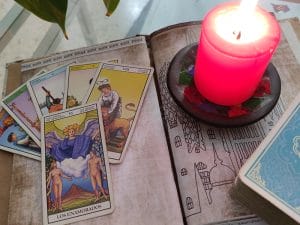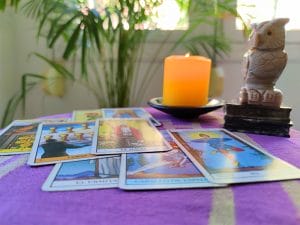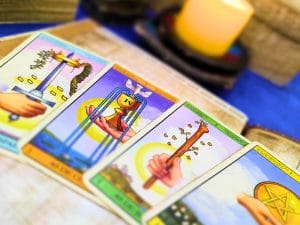Advanced Tarot Spread: The Tree of Life
The “Tree of Life” is an advanced, complex, and fascinating tarot spread. It’s well-known but often misunderstood. It’s based on the Tree of Life diagram from Qabbaláh (Kabbalah).
Use it when you want to do a deep analysis of your general state of consciousness or in relation to a specific topic.
When and why should you use this advanced tarot spread?
Additional Instructions for Interpreting this Spread
The Tree of Life is an ancient Qabbalistic diagram of energy and its movements between the physical and divine worlds. It’s a diagram of human consciousness believed to have originated as far back as the 9th century BC.
We all exist in different worlds at the same time (spiritual, romantic, work), and the Tree, with its different levels, is a perfect way to visualize and understand who we are, from our daily lives to our highest spiritual experiences.
The Tree of Life contains ten positions called sephiroth (singular, sephirah), which represent the ten states of consciousness. The word comes from Hebrew and means “sapphire,” forming a perfect pattern of development.
Energy moves from the totality and perfect unity of the Crown, sephirah 1, to the vibrant complexity of daily life in the world we see around us every day, known as sephirah 10, Kingdom.
Ten, not nine, and not eleven. In fact, tradition teaches that an eleventh sephirah has the potential to exist, in a sort of gap between the top three Sephiroth and the lower seventh. This sephirah, called Da’ath in Hebrew (meaning Knowledge), is more of a possibility than a fixed state. That’s why Da’ath becomes a line of transformation.

How can this tarot spread be approached?
There are two ways to approach this classic spread, depending on how deep you want to go.
One of them, the simpler version, is placing one card per sephirah. The other, more complex of course, is using all the cards in the deck, except for the significator (which is a court card that represents you or the person you’re reading for). In this case, you’ll be left with 77 cards, which are distributed in groups of 7 for each position.
For this example, we’ll use the version with only one card per position, but if you decide to do the extended version, interpret each group of 7 cards as telling the story of each position.
**CLARIFICATION: There is no single version of this spread; it has evolved over the years, and each tarot reader tends to make their own “adjustments” to create more fluid interpretations.
Can anyone do this advanced tarot spread?
Yes and no. A beginner can certainly try it because, in a way, you gain experience with tarot by doing readings, but it will be difficult to understand such mystical positions, though not impossible.
I wouldn’t recommend starting with this if you’re just learning how to read tarot or if this is your first reading, but I definitely support trying it and experimenting. Tarot connects with each person in unique and special ways, and I believe you should explore and try different spreads.
The Tree of Life is an advanced, introspective, complex, and subtle tarot spread, but with wonderful variations and movements of energy that will help you get to know yourself on a deeper level and understand the background of everything around you.
A final suggestion
Interpret each sephirah or position as your state of consciousness and transcendence in that specific area.
For example, when interpreting the position of Mercy, you will look at, among other things, your level of mercy both toward yourself and toward others.
When interpreting the position of the Kingdom, evaluate your state of consciousness regarding your physical body and the material world. The goal of this spread, besides getting to know yourself, is to balance each state of consciousness to bring yourself closer to a state of “divinity,” or what I see as its synonym: fulfillment and happiness.
The sephiroth positions of this tarot spread:

CARD 1: Kether / Crown
The spiritual world, the highest spiritual aspirations of the querent. It’s also the “key” or “crowning” of spiritual influence in life: for lack of a better term, the “God card.” Unity.
Cards in this line should generally be interpreted positively, from a growth perspective, reaching a higher level.
If you’re using 7 cards, some cards may reveal what blocks you from achieving this higher level. It has no planetary correspondence, although some astrologers associate it with the Cosmos as a whole.
CARD 2: Hokhmah / Wisdom
How wise are you? What in your life leads you to wisdom? Here, you can see the spiritual potential achieved through personal initiative.
It’s the card of anointing and of sonship. It may also represent a long-term outcome, which is probably not yet visible. Alternatively, this card can also show your father’s influence. It has no planetary equivalent.
CARD 3: Binah / Understanding
What’s your understanding of the world? What have you learned? This card can also show spiritual limitations and restrictions.
It’s the card of the Shekinah, the spirit manifested in humanity. It may also suggest a short-term outcome, possibly visible.
Alternatively, this card can show your mother’s influence. Planetarily, it corresponds to Saturn: “What is born from going beyond limits.”
CARD 4: Chesed / Mercy
How generous are you? In what ways has life been good to you? Once again, some cards may show what blocks the good things in life.
This card allows us to interpret generosity, prosperity, and constructive influences in general. It also shows our financial success. Planetarily, it corresponds to Jupiter: “the greatness of spirit.”
CARD 5: Geburah / Severity
In what ways has life been tough for you? What tests you, what crises must you face? How do you express your power? This card speaks of hardship, anger, and destructive influences in general.
It also speaks of the use and misuse of power. Planetarily, it corresponds to Mars: “aggressive force.”
CARD 6: Tiphereth / Beauty
Where does beauty lie in your life? What’s at the core of who you are? This card represents the true “Self,” the heart of the matter, the intersection of divine will and human aspiration.
It may also show current achievements. Planetarily, it corresponds to the Sun: “How do you shine?”
CARD 7: Netzach / Victory
What are your victories? How do you direct your will? This card represents love, passion, and enthusiasm, the emotional state of the querent.
It also speaks of romance and relationships. Planetarily, it corresponds to Venus: “The emotions.”
CARD 8: Hod / Splendor
What are your intellectual achievements? What makes you special in your life? How do you share your splendor with others? What do others see as good in you?
This card represents the splendor of the mind and intellect, communication, creativity, intelligence, and the intellectual state of the querent.
It can also show us information about work and career. Planetarily, it corresponds to Mercury: “The intellect.”
CARD 9: Yesod / Foundation
What are the foundations of your life? What’s at the base, and what might you be unaware of? This card represents intuition, psychic receptivity, and the unconscious state of the querent.
It may also show hidden dreams and desires. Planetarily, it corresponds to the Moon: “Imagination, dreams, stories.”
CARD 10: Malkuth / Kingdom
What’s your world like, the one you live and act in? What effect do external events or other people have? This card represents the material world in all its manifestations: the physical state of the querent and the world they inhabit.
It may also refer to family matters. Planetarily, it corresponds to Earth: “The body.”
CARD 11: Da’ath / Knowledge
Initially, in this advanced tarot spread, this card may represent a shadow or hidden knowledge: something unknown or a possible future. How can you transform things in your life? What will make change possible?
This card will also show you the tools you have to make the changes you need in all areas of life. What should you do to transcend to full happiness? Planetarily, it has no equivalent.
Dejame tus Comentarios AQUI
Colabora con el mantenimiento del Blog
Si encuentras que mis contenidos te han sido de utilidad, los consultas con frecuencia y quieres agradecer y colaborar con el mantenimiento de la web para seguir mejorando, puedes hacerlo a través de una donación. Aunque mínima, será de gran ayuda para seguir en línea.
Pídeme tu Lectura

3 Preguntas
¿Tienes preguntas especificas? Aquí puedes realizar hasta 3 preguntas de un mismo tenor o de diferentes temas

¿Debo continuar?
¿Te encuentras en la disyuntiva si debes continuar con tu pareja o no? Esta es tu lectura

Mi futuro general
¿Qué te depara el futuro a corto plazo? ¿Qué puedes esperar de los próximos 1 a 6 meses?










